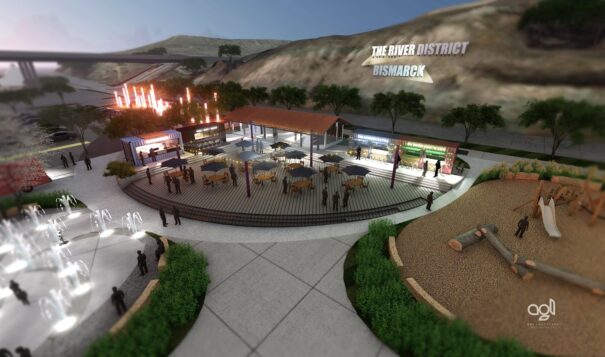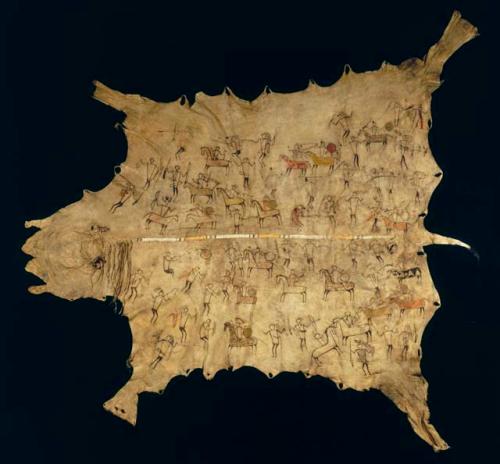News Based on facts, either observed and verified directly by the reporter, or reported and verified from knowledgeable sources.
As plans mature for Missouri River development, Natives call for inclusion of forgotten history
 Plans are in motion to transform Keelboat Park into “The River District,” a family-friendly area on Bismarck’s Missouri River front with access to water recreation, concerts, parking, and vendors in addition to a small boutique-style hotel. Illustration Rendering Courtesy/AGL Landscape Architects.
Plans are in motion to transform Keelboat Park into “The River District,” a family-friendly area on Bismarck’s Missouri River front with access to water recreation, concerts, parking, and vendors in addition to a small boutique-style hotel. Illustration Rendering Courtesy/AGL Landscape Architects.
Beneath the serene flow of the Missouri River along Bismarck’s riverfront runs a deeper current, one that carries the stories of its original inhabitants. As state and local governments work together to outline a vision for a new, multi-million dollar development project, Indigenous leaders expressed their hopes that their rich and hidden history here will be a meaningful part of it.
A series of three public forums – sponsored by the Department of Commerce Tourism Division, Missouri Valley Heritage Alliance and the City of Bismarck – were held in mid-March to gather input on a “Big Idea” for the riverfront that would amp up the area’s tourism appeal while providing an inclusive space for the community. The plan includes developing a park and festival grounds, an amphitheater and a boutique-style hotel.
Melanie Moniz, a citizen of the Mandan, Hidatsa and Arikara Nation and a representative with National Folklife Network — a nonprofit focused on folk and traditional art — was invited to speak at two of the three community forums on March 13 and 14 to offer some history of this region’s original people, and about her connection to the river. She supports the idea of improving the riverfront and making it into a safer space.
“This project will take a vacant lot in which many women and individuals have experienced violence, and turn it into a public space that will bring families and people together.” Moniz said.
“Let’s keep in mind how we move forward and create this design, how we think about and lift up cultures, and how we create something beautiful together in this place that our people have long called Nuhųųre Nátkanito’sh, the Heart of Our Mother.”
Moniz encouraged those at the public forum to remember the area was the ancestral home of the Mandan, or Nueta, people for some 1,000 years before the tribe moved their earth lodge towns north along the Missouri River. Today, thousands of Nueta descendants remain part of the local community.
The Big Idea
Over the past few years, planning surveys by project developers AGL Landscape Architects have demonstrated an interest in building this area up and improving river access. For two years, stakeholders and project researchers have been discussing the Bismarck Riverfront idea, a proposed development project for a 19-mile stretch of riverfront beginning at Misty Waters to the north and ending at the Apple Creek confluence to the south, near the University of Mary.
“The Big Idea” includes a river district area that focuses on improving the area between Pioneer Park and Sertoma Park, and a bigger picture of how the riverfront area in Bismarck can be developed for better public use.
In November 2023, the Fort Abraham Lincoln Foundation, now branded as the Missouri River Heritage Alliance, was awarded a $4 million planning grant from the North Dakota Department of Commerce, Tourism Division. The project was combined with a 10% local match from the City of Bismarck plus a donation of 4.4 acres of Keelboat Park.
The grant aimed to explore ways to enhance tourism along the Missouri River in Bismarck. According to North Dakota Tourism, the state brings nearly 22 annual visitors and $3 billion to the state’s economy, making it the state’s third-largest industry.
“The vision for this master plan is to bolster the state and local economy through tourism, while improving the Missouri River’s appeal to locals and visitors alike,“ according to the Bismarck Riverfront Project website. “[This idea] imagines a more accessible, inclusive, and marketable riverfront that is an engine for the tourism industry, a tool for regional workforce attraction and retention, and an indelible part of our culture, identity, and quality of life.”
Remembering Our History
The festival grounds will offer a place for artist’s work to represent North Dakota’s historical and contemporary heritage. Dakota Goodhouse, an instructor of Native American Studies at United Tribes Technical College – and a former historian at the Fort Abraham Lincoln Foundation and State Park – encouraged community members to remember First Nations people as the development progresses.
Goodhouse was invited to speak at the March 14 forum. He is a citizen of the Standing Rock Sioux Tribe which is about 40 miles to the south of Mandan. During the breakout sessions, he shared what he hopes to see in this space; a rich display of culture that has been completely overlooked and ignored by local institutions.
“We should celebrate what’s already here, and that includes more than just a few interpretive panels at General Sibley Park,” he said. “The Apple Creek Fight was four days long and included 2,400 Civil War soldiers against 500 of my people’s warriors. This conflict was bigger than the Little Bighorn, and all of us have heard about Little Bighorn.”
The battle was considered a tertiary Civil War conflict, he said, but that historical event has gone unrecognized.
“You can go anywhere else in the country and we can see how they observe or commemorate their Civil War history,” he said. “We don’t do that here. We develop over these places.”
The site is also at the northeastern point of the 1851 Fort Laramie Treaty, the boundary destination. “There isn’t anything here in the Heritage Center that mentions that or at Fort Abraham Lincoln State Park,” Goodhouse pointed out. “These are ‘Nation founding’ events at a time where our country embraced Manifest Destiny.”

Another battle happened on the river, this one before the Lewis and Clark Expedition. Recorded on a bison robe given to the Corp of Discovery was a depiction of the 1803 Battle of Heart River.
“There is no memorial of that in any of these institutions,” said Goodhouse. “No one will tell you about this at Fort Lincoln State Park, or at Knife River Indian Villages National Historic Site. We have places that already exist that we should remember and consider.”
Historical accounts of the conflicts mentioned can be found in detail at Goodhouse’s website, The First Scout.
Looking forward
Meanwhile, no additional public meetings have been announced for the project that’s expected to cost $10-12 million. In addition to the $4.5 million set aside for the project, a $750,000 Sovereign Lands Water Recreation Grant was awarded through the state’s Parks and Recreation Department. Also, the Bismarck-Mandan Convention and Visitors Bureau awarded the project $500,000.
AGL Landscape Architects is also pursuing additional federal grant opportunities. The public is invited to submit ideas on the riverfront project.
Sourcing & Methodology Statement:
The Bismarck Riverfront Idea (2024) https://www.bismarckriverfront.com/
The Bismarck Riverfront Idea (2024) “Care to Share your Thoughts?” https://www.bismarckriverfront.com/thoughts
Tourism, North Dakota State Government Portal (2024) “Tourism: Where Historic Legends Inspire Today’s Trailblazers.” https://www.nd.gov/innovation-industries/tourism
Wind, D. (2011, Sept 5) “Fort Abraham Lincoln State Park Battles And Skirmishes In And Around Site.” The First Scout: Ocheti Shakowin History and Culture. https://thefirstscout.blogspot.com/2011/09/battles-skirmishes-around-fort-abraham.html
Wind, D. (2015, Jan 28) “Warfare On The Northern Plains Painted Robe Reveals Battle”. The First Scout: Ocheti Shakowin History and Culture. https://thefirstscout.blogspot.com/2015/01/warfare-on-northern-plains-interpreting.html
